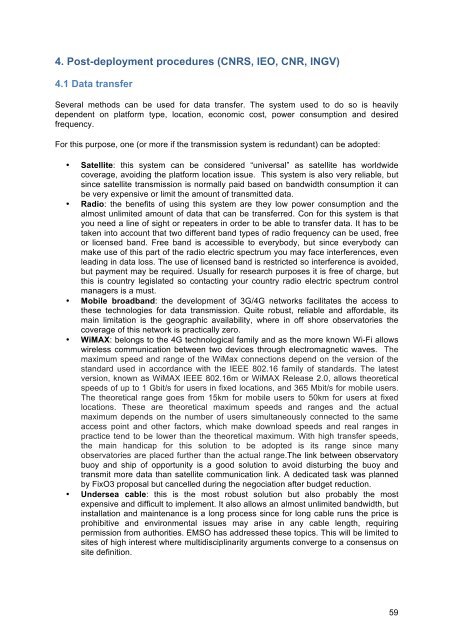Handbook of best practices
Handbook%20of%20best%20practices
Handbook%20of%20best%20practices
Create successful ePaper yourself
Turn your PDF publications into a flip-book with our unique Google optimized e-Paper software.
4. Post-deployment procedures (CNRS, IEO, CNR, INGV)<br />
4.1 Data transfer<br />
Several methods can be used for data transfer. The system used to do so is heavily<br />
dependent on platform type, location, economic cost, power consumption and desired<br />
frequency.<br />
For this purpose, one (or more if the transmission system is redundant) can be adopted:<br />
• Satellite: this system can be considered “universal” as satellite has worldwide<br />
coverage, avoiding the platform location issue. This system is also very reliable, but<br />
since satellite transmission is normally paid based on bandwidth consumption it can<br />
be very expensive or limit the amount <strong>of</strong> transmitted data.<br />
• Radio: the benefits <strong>of</strong> using this system are they low power consumption and the<br />
almost unlimited amount <strong>of</strong> data that can be transferred. Con for this system is that<br />
you need a line <strong>of</strong> sight or repeaters in order to be able to transfer data. It has to be<br />
taken into account that two different band types <strong>of</strong> radio frequency can be used, free<br />
or licensed band. Free band is accessible to everybody, but since everybody can<br />
make use <strong>of</strong> this part <strong>of</strong> the radio electric spectrum you may face interferences, even<br />
leading in data loss. The use <strong>of</strong> licensed band is restricted so interference is avoided,<br />
but payment may be required. Usually for research purposes it is free <strong>of</strong> charge, but<br />
this is country legislated so contacting your country radio electric spectrum control<br />
managers is a must.<br />
• Mobile broadband: the development <strong>of</strong> 3G/4G networks facilitates the access to<br />
these technologies for data transmission. Quite robust, reliable and affordable, its<br />
main limitation is the geographic availability, where in <strong>of</strong>f shore observatories the<br />
coverage <strong>of</strong> this network is practically zero.<br />
• WiMAX: belongs to the 4G technological family and as the more known Wi-Fi allows<br />
wireless communication between two devices through electromagnetic waves. The<br />
maximum speed and range <strong>of</strong> the WiMax connections depend on the version <strong>of</strong> the<br />
standard used in accordance with the IEEE 802.16 family <strong>of</strong> standards. The latest<br />
version, known as WiMAX IEEE 802.16m or WiMAX Release 2.0, allows theoretical<br />
speeds <strong>of</strong> up to 1 Gbit/s for users in fixed locations, and 365 Mbit/s for mobile users.<br />
The theoretical range goes from 15km for mobile users to 50km for users at fixed<br />
locations. These are theoretical maximum speeds and ranges and the actual<br />
maximum depends on the number <strong>of</strong> users simultaneously connected to the same<br />
access point and other factors, which make download speeds and real ranges in<br />
practice tend to be lower than the theoretical maximum. With high transfer speeds,<br />
the main handicap for this solution to be adopted is its range since many<br />
observatories are placed further than the actual range.The link between observatory<br />
buoy and ship <strong>of</strong> opportunity is a good solution to avoid disturbing the buoy and<br />
transmit more data than satellite communication link. A dedicated task was planned<br />
by FixO3 proposal but cancelled during the negociation after budget reduction.<br />
• Undersea cable: this is the most robust solution but also probably the most<br />
expensive and difficult to implement. It also allows an almost unlimited bandwidth, but<br />
installation and maintenance is a long process since for long cable runs the price is<br />
prohibitive and environmental issues may arise in any cable length, requiring<br />
permission from authorities. EMSO has addressed these topics. This will be limited to<br />
sites <strong>of</strong> high interest where multidisciplinarity arguments converge to a consensus on<br />
site definition.<br />
59


